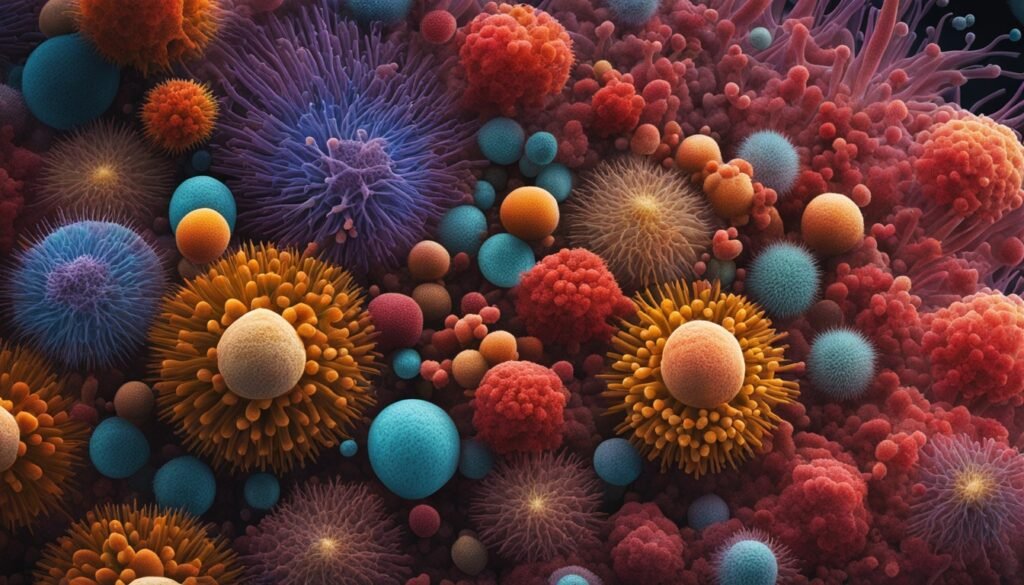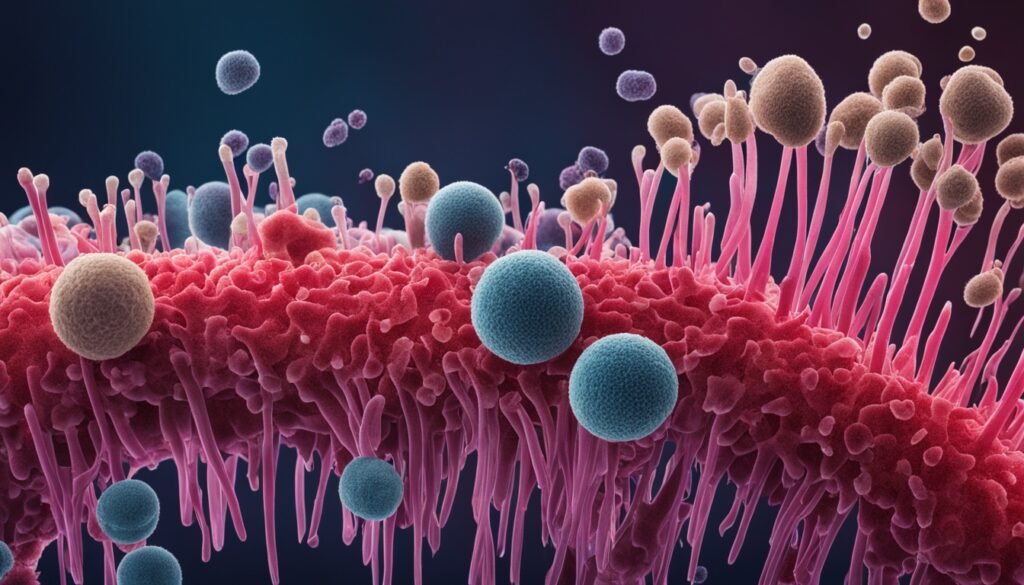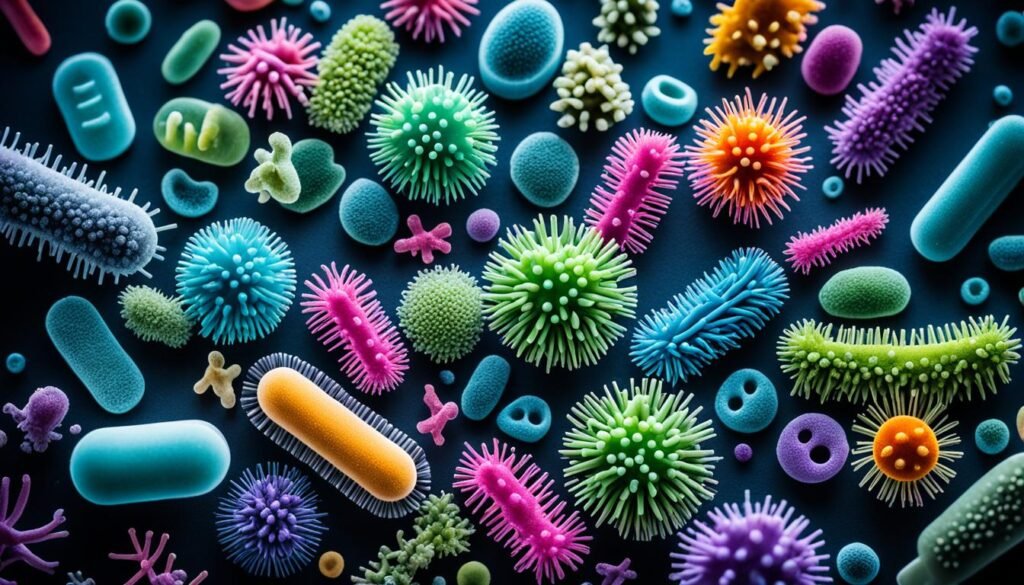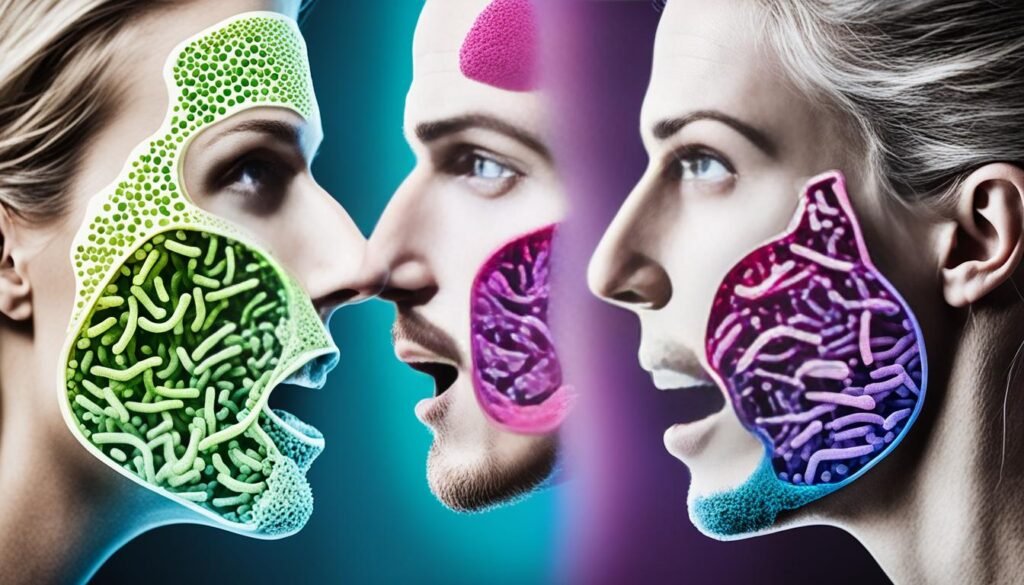I’ve always been drawn to the complex world of oral health. Growing up, I learned that Streptococcus mutans was the main cause of cavities. This idea was widely accepted for many years. But, my view changed with new research on the diversity of the oral microbiome.
Our mouths are filled with a complex mix of microbes, not just one bad bug. Scientists now question the old idea that one germ causes all dental problems. They show how many different microbes work together in our mouths. And how disruptions in this balance can lead to oral health issues.
Key Takeaways
- The oral cavity hosts a diverse microbial community, not just a single culprit bacterium.
- Challenging the longstanding “one bug, one disease” model of dental caries.
- Exploring the complex interplay between the oral microbiome and oral health.
- Disruptions in the delicate balance of the oral microbiome can contribute to various oral diseases.
- Embracing a microbiome-centric approach to understand and treat oral health conditions.
Challenging Dental Dogma with Oral Microbiome Research
We used to think Streptococcus mutans was the main cause of dental caries. But now, thanks to new tech and research, we know the oral microbiome is much more complex. This has changed how we view oral health and disease.
Studies show that the diversity of dental bacteria has decreased over time. This change happened from hunter-gatherer times to today. Now, over 600 types of bacteria live in our mouths, showing a rich mix of microbes.
Some bacteria in our mouths can cause cavities and gum disease. This shows how important oral microbes are for our health. Eating more processed foods and heavy dyes has changed our mouth’s bacteria, making them better at surviving in an acidic world.
“Untreated cavities can result in various health issues, including kidney, pancreatic, oral, blood, and throat cancer, as well as brain and heart infections, emphasizing the importance of maintaining oral health.”
Our diet, evolution, and culture have shaped our oral microbiome. This means our oral health challenges are linked to how our microbiome has evolved. This new knowledge is making us rethink oral health and disease. We’re moving towards a more microbiome-centric dentistry.
Unraveling the Complexity of the Oral Microbiome
The mouth is filled with over 700 types of bacteria. This mix of microorganisms changes often, affected by what we eat, how we brush our teeth, and other factors. Keeping the balance right is key, as too many bad bacteria can cause mouth diseases like cavities and gum disease.
Bacterial Diversity in the Oral Cavity
The mouth’s microbiome is full of different bacteria living together in a balance. This balance is important for good oral health. Eating habits, brushing teeth, and using mouthwash can change the bacterial diversity in the oral cavity. This can lead to more harmful bacteria and dental issues.
Microbial Shifts and Oral Health
Changes in the microbial shifts and oral health can affect our mouth’s health. If the oral microbiome diversity drops, bad bacteria can grow. This can cause cavities, gum disease, and bad breath. Knowing how different bacteria affect our mouth’s health helps us find ways to prevent and treat problems.
| Oral Health Condition | Microbial Shifts Associated |
|---|---|
| Dental Caries | Increased abundance of Streptococcus mutans and other acidogenic bacteria |
| Periodontal Disease | Overgrowth of anaerobic, Gram-negative bacteria like Porphyromonas gingivalis and Tannerella forsythia |
| Halitosis (Bad Breath) | Increased levels of volatile sulfur-producing bacteria, such as Fusobacterium and Veillonella species |
“Understanding the complexity of the oral microbiome is crucial for maintaining optimal oral health and developing targeted strategies to address dental diseases.”
The Rise and Fall of Streptococcus mutans
For years, Streptococcus mutans was seen as the main cause of tooth decay. It thrives in acidic places and makes lactic acid that can harm tooth enamel. This made it a key focus in dental research and oral hygiene.
But, our knowledge about the oral microbiome has changed things. Now, we see S. mutans as just one part of a complex mix of bacteria. It’s not the only cause of tooth decay anymore.
| Microorganism | Prevalence in Oral Microbiome | Role in Oral Health |
|---|---|---|
| Streptococcus mutans | Commonly found in the oral cavity | Linked to the development of dental caries |
| Lactobacilli | Also commonly found in the oral cavity | Contribute to the acidic environment that can lead to tooth decay |
| Bifidobacteria | Present in the oral microbiome | May have a protective role against dental caries |
| Porphyromonas gingivalis | Associated with periodontal disease | Linked to the development of gum disease and potential systemic health issues |
Recent studies reveal the oral microbiome is complex and ever-changing. The way different bacteria interact is key to keeping our mouths healthy. Saliva microbiomes can tell us if someone has cavities or not. This shows how a balanced oral microbiome is crucial for good oral health.
We’re learning more about the oral microbiome, and our view of Streptococcus mutans is changing. A new, more complete approach to oral health is coming into focus.
Emerging Roles of the Oral Microbiome
The oral microbiome is a complex ecosystem that keeps our mouths healthy. It’s not just about fighting cavities anymore. Now, we know it also helps control dysbiosis and inflammation. This knowledge is leading to new ways to take care of our teeth.
Modulating Dysbiosis and Inflammation
When the balance of mouth bacteria gets upset, it can lead to disease. This imbalance, called dysbiosis, can cause inflammation and harm our gums. Scientists are finding new ways to fix this balance and reduce inflammation.
They’re looking at prebiotics and probiotics to help good bacteria grow. This can lessen the harm from dysbiosis and reduce inflammation.
Also, new tech like metagenomics and metabolomics is helping us understand how our mouth’s bacteria work with our genes and the world around us. This knowledge is key to making treatments that really target the root of mouth problems.
As we learn more about the oral microbiome, we’re moving towards a future where oral care is more personal. It will focus on keeping our mouths in balance for better health.
“The oral microbiome is a complex and dynamic ecosystem, playing a crucial role in maintaining overall oral health.”
Saliva Metagenomics: A Window into Oral Health
Saliva is a key biological fluid that tells us a lot about the oral microbiome. Thanks to metagenomics, we can now study the genetic material in saliva. This lets researchers explore the complex life in our mouths.
By looking at DNA and RNA in saliva, scientists can spot the different microorganisms in our mouths. They can see how many of each type there are. This helps us understand how our mouth’s microbes affect our health.
Saliva metagenomics has changed how we see our mouths. It has challenged old dental beliefs and shown us the importance of balanced microbes for good health. This new field is helping us find new ways to prevent and treat mouth diseases.
| Key Findings from Saliva Metagenomics Research | Implications for Oral Health |
|---|---|
|
|
As we keep exploring the oral microbiome with saliva metagenomics, we’re changing how we think about oral health. This new field offers chances for personalized dental care and better disease prevention. It also helps us understand how our microbes and health are connected.
Microbiome Diversity and Oral Diseases
The oral microbiome’s diversity is key to understanding and managing oral health issues. Too many harmful bacteria, like Streptococcus mutans, can lead to dental caries. But, losing diversity in the microbiome is linked to periodontal disease.
Dental Caries and Periodontal Disease
Keeping the oral microbiome diverse helps prevent dental caries and periodontal disease. When the balance of mouth bacteria is off, harmful bacteria can grow more easily. This leads to oral health problems.
| Oral Disease | Microbial Diversity Impact | Key Factors |
|---|---|---|
| Dental Caries | Decreased diversity linked to increased risk | Overgrowth of Streptococcus mutans and other acidogenic bacteria |
| Periodontal Disease | Loss of diversity associated with disease progression | Imbalance in beneficial and pathogenic bacteria, leading to inflammation and tissue damage |
Researchers are looking into how a diverse oral microbiome can prevent and treat oral diseases. By understanding how microbes and diseases interact, healthcare can offer better treatments. This helps keep our mouths healthy and our overall well-being in check.
Sex Differences in the Oral Microbiome
Research is showing interesting differences in the oral microbiome based on sex. These differences suggest that our biology and traits affect the microbes in our mouths. This could lead to new ways to take care of our oral health, focusing on our unique microbial makeup.
Host Traits and Causal Relationships
Studies now tell us that most of the microbes in our mouths belong to the Firmicutes phylum. Streptococcus makes up about 36.7% of these microbes. Interestingly, people with periodontitis have more diverse microbes in their mouths than those with healthy gums.
This means that changes in the types of microbes we have might lead to oral diseases.
| Key Findings | Implications |
|---|---|
| Specific oral pathogens like Streptococcus mutans and Porphyromonas gingivalis were significantly increased in patients with periodontal disease and atherosclerosis. | The density of the oral microbiota is positively correlated with the severity of periodontal parameters and the number of periodontal pathogens. |
| Certain oral commensal bacteria found in coronary plaques are also present in non-cardiac organs. | Patterns of oral dysbiosis may induce the host’s immune response, leading to systemic implications. |
These discoveries show how our traits, like sex, affect the microbes in our mouths. By understanding these connections, we can develop better oral health care plans. These plans would consider each person’s unique microbial makeup.
Precision Oral Hygiene and Prebiotic Dental Care
Our understanding of the oral microbiome is growing, leading to new ways to keep teeth healthy. Researchers are looking into “precision” oral hygiene products. These products target bad bacteria while keeping good bacteria safe. They also explore prebiotics, which help good bacteria grow, to support a healthy oral microbiome.
The Human Genome Project finished in 2003 sped up gene mapping for oral health. Since then, many studies have looked into genes and diseases, including those linked to gum disease.
New tech like phenomics and single-cell omics are changing dentistry. Phenomics measures and analyzes traits, while single-cell omics looks at single cells to understand disease risks and treatment effects.
As we learn more about the oral microbiome, precision oral hygiene and prebiotic dental care will be key. They help keep the mouth balanced and support overall health.
“Good” bacteria can stop bad bacteria from causing disease by taking up space in the oral microbiome.
| Key Findings | Implications |
|---|---|
| The oral microbiome is full of different microbes that affect dental health and overall well-being. | Knowing how these microbes work together is important for making targeted precision oral hygiene and prebiotic dental care products. |
| Some bacteria in the oral microbiome increase disease risk, while others help prevent it. | Targeting bad bacteria while keeping good ones safe is a main goal of precision oral hygiene products. |
| Prebiotics help good bacteria grow in the oral microbiome. | Prebiotic dental care aims to keep the oral microbiome balanced and lower disease risk. |
Disruptive Oral Health: Microbiome-Centric Dentistry
The way we see the oral microbiome is changing, leading to new ways in dentistry. Now, we focus on keeping a healthy balance of oral microbiome for better oral health. This new view is shaking up old dental ideas and bringing in new ways to use the oral microbiome.
Recent studies show how complex and ever-changing the oral microbiome is. A 2021 study in BMC Biology found that oral microbiome research is changing old dental beliefs. It had over 3,500 reads and 15 references. The study looked at how periodontal disease changes and the microbes behind it with 415 people involved.
Keeping a healthy oral microbiome is key to stopping and managing oral diseases. Pathogenic bacteria cause up to 80% of chronic infections globally. With more antibiotic-resistant infections, we need new ways to fight them.
Microbiome-centric dentistry uses probiotics and good microbes to keep the oral microbiome balanced. Research shows probiotics like Lactobacillus and Bifidobacterium can stop harmful biofilms. This could be a big step against antibiotic resistance.
As we learn more about the oral microbiome, microbiome-centric dentistry is changing oral health care. Dental experts can now offer personalized, holistic care that focuses on the oral microbiome.
“The oral microbiome plays a crucial role in dental caries and periodontitis and contributes to overall health.”
Oral Dysbiosis and Systemic Implications
Research shows that oral dysbiosis, or an imbalance in oral bacteria, can affect our overall health. It’s linked to heart disease, diabetes, and some cancers. This has led to interest in therapies that target the microbiome to prevent these health issues.
Microbiome-Targeted Therapies
Using probiotics to fix an unhealthy oral microbiome is a promising method. Studies highlight how certain probiotics, like Bacillus coagulans, can help fight inflammation. Phage-based treatments, which use viruses to target bad bacteria, are also being explored as a way to tackle oral dysbiosis.
People with type 2 diabetes and gum disease often have high inflammation. This can make it hard for the body to fight inflammation. This chronic inflammation raises the risk of heart disease and other health problems. By treating oral dysbiosis with targeted therapies, we might reduce these risks and improve health outcomes.
“Emerging evidence suggests nonresolving inflammation is a critical factor in periodontitis and type 2 diabetes.”
As we learn more about how oral bacteria affect our health, developing therapies to fix oral dysbiosis is key. These therapies could help prevent many health issues.
Microbiome Modulation: A New Frontier
Modulating the oral microbiome is a new and exciting area in oral health. Researchers are looking into new ways like using prebiotics, probiotics, and fecal microbiome transplants. These methods aim to change the mouth’s microbial mix for a healthier balance. This could change how we prevent and treat oral health problems, starting a new era in dentistry focused on the microbiome.
Dealing with antibiotic-resistant bacteria is a big challenge in oral health. These bacteria cause up to 80% of chronic infections worldwide, leading to over 2.8 million infections and 35,000 deaths a year in the U.S. Traditional dental treatments often use too many antibiotics, making these superbugs worse. But, microbiome modulation could be a solution by balancing oral microbes without needing lots of antibiotics.
Probiotics are a promising way to change the microbiome. These live microorganisms can be good for our health. They’re often used for the gut but can also help the skin, urinary tract, and oral microbiome. Some probiotics can stop bad bacteria from growing and sticking to teeth, helping prevent cavities and gum disease.
Researchers are also looking at prebiotics and fecal microbiome transplants to change the oral microbiome. Prebiotics are fibers that help good microbes grow. Fecal microbiome transplants move a healthy gut microbiome into someone else’s body to fix their bad microbial mix.
As we learn more about the oral microbiome and its role in oral health, these new methods could change dental care. By working with the microbial community, we can move towards a future where dental care focuses on keeping the mouth healthy overall, not just treating problems as they come.
“The ability to actively modulate the oral microbiome represents a new frontier in the field of oral health, with the potential to revolutionize the way we prevent and treat a wide range of oral health issues.”
The Evolution of Oral Health: From Dogma to Diversity
Understanding the oral microbiome has changed a lot. We used to think that one bug caused one disease. Now, we see it’s more complex. Researchers are learning more about the microbes in our mouths. This new knowledge is changing how we care for our teeth and gums.
Studies now show that bacteria aren’t the only cause of dental problems. They tell us that the balance and variety of microbes in our mouths are key to good oral health. ProDentim, a new oral probiotic, shows how we can support our mouth’s health by helping its natural balance.
ProDentim has 3.5 billion probiotic strains, including Lactobacillus Paracasei, B.lactis BL-04®, and Lactobacillus Reuteri. It also has prebiotics like Inulin, Malic Acid, and Tricalcium Phosphate. This mix helps balance the good bacteria in our mouths, like in ancient times when people had fewer dental problems.
This new view on the oral microbiome changes how we think about oral health. ProDentim is leading this change by focusing on the mouth’s ecosystem. It aims to make our smiles healthier and more resilient. This new way of thinking is changing how we care for our oral health.
“The evolution of oral health is moving away from rigid dental dogma and embracing the complexity and diversity of the oral microbiome. This shift is essential for promoting long-term oral health and wellness.”
Conclusion: Embracing Microbiome-Centric Approaches
Recent research has changed how we think about oral health. It’s moving us towards a new way of caring for our teeth. By understanding the complex world of mouth bacteria, we can fight oral diseases better.
This new approach means we can create treatments that work better for each person. It’s a shift towards a healthier smile for everyone. By focusing on the balance of bacteria in our mouths, we’re stepping into a new era of dental care.
The future of dental health looks bright with this new focus. Dental schools are growing, and new challenges are coming up in Southeast Asia. By leading in microbiome-centric dentistry, we can give our patients the best care. This leads to better health for everyone’s smiles.
FAQ
What is the significance of recent oral microbiome research in challenging long-held dental dogma?
Recent studies have changed how we see the mouth’s bacteria. They show the mouth has many different bacteria, not just one bad one. This new view is making us rethink oral health and disease.
How has the exploration of the full diversity of the oral microbiome impacted our understanding of dental diseases?
New tech lets us study the mouth’s bacteria fully. We now know the mouth has hundreds of types of bacteria. This means dental caries isn’t just one bacterium’s fault. It’s about how different bacteria work together with our bodies.
What is the role of Streptococcus mutans in the development of dental caries?
Before, Streptococcus mutans was seen as the main cause of cavities. It loves acidic places and makes acid that can harm teeth. But now, we see it as part of a bigger group of bacteria that affects our oral health.
How can disruptions in the oral microbiome, known as dysbiosis, lead to the development of oral diseases?
When the balance of mouth bacteria gets upset, bad bacteria can grow too much. This can cause inflammation and diseases like gum disease. Researchers are finding ways to fix this balance to improve oral health.
What insights can saliva metagenomics provide about the oral microbiome and its relationship to overall oral health?
Saliva gives us clues about the mouth’s bacteria. With new tech, we can study saliva to learn about the bacteria types and how they change. This helps us understand how our oral health is linked to our overall health.
How does microbial diversity in the oral cavity impact the development of dental caries and periodontal disease?
Having many types of bacteria in the mouth is important for our health. Too many bad bacteria can cause cavities and gum disease. Finding ways to keep the mouth’s bacteria balanced is key to preventing these diseases.
What are the potential implications of sex-based differences in the oral microbiome?
Research shows men and women have different mouth bacteria. This could mean we need different ways to keep our mouths healthy. Tailored health care based on our biology could be the future.
How are researchers developing “precision” oral hygiene products and prebiotic dental care to support a healthy oral microbiome?
New products are being made to help keep our mouth’s bacteria balanced. Some products target bad bacteria while keeping good ones. Prebiotics are also being studied to help good bacteria grow.
How is the shift in understanding the oral microbiome leading to a paradigm shift in the field of dentistry?
We’re moving from just treating diseases to keeping the mouth’s bacteria balanced. This new focus is changing dentistry. It’s making us think differently about how to keep our mouths healthy.
What are the potential systemic implications of oral dysbiosis, and how are researchers developing microbiome-targeted therapies to address this?
Bad balance in mouth bacteria might affect our overall health. It could be linked to heart disease, diabetes, and cancer. Researchers are working on new treatments, like probiotics, to fix this balance and protect our health.
What are the emerging strategies for actively modulating the oral microbiome, and how can these approaches revolutionize oral health care?
We’re finding new ways to change the mouth’s bacteria for the better. Using prebiotics, probiotics, and more, we can make our mouths healthier. These methods could change how we prevent and treat oral health issues, making dentistry more advanced.
Source Links
- https://europepmc.org/article/med/34707271 – Oral microbiome findings challenge dentistry dogma. – Abstract
- https://www.ncbi.nlm.nih.gov/pmc/articles/PMC8945538/ – Oral Microbiome: Getting to Know and Befriend Neighbors, a Biological Approach
- https://colab.ws/articles/10.1038/d41586-021-02920-w – Oral microbiome findings challenge dentistry dogma
- https://blogs.iu.edu/ecohealth/2021/12/13/726/ – Ever-changing Diversity of the Microbiome of the Mouth
- https://www.bristlehealth.com/blogs/news/bristle-oral-health-test-white-paper?srsltid=AfmBOooyyEHbOVEnbkGiArK71ydxwUfk2we_8Ppspvn3RMlALt3qgL7h – Bristle Oral Health Test White Paper
- https://khni.kerry.com/nutrition-resources/the-human-microbiome-beyond-digestive-health/ – The Human Microbiome: Beyond Digestive Health – KHNI
- https://www.ncbi.nlm.nih.gov/pmc/articles/PMC9247192/ – Current State and Challenges of the Global Outcomes of Dental Caries Research in the Meta-Omics Era
- https://www.ncbi.nlm.nih.gov/pmc/articles/PMC10608847/ – The Future Is Now: Unraveling the Expanding Potential of Human (Necro)Microbiome in Forensic Investigations
- https://microbiomejournal.biomedcentral.com/articles/10.1186/s40168-020-00875-0 – Microbiome definition re-visited: old concepts and new challenges – Microbiome
- https://www.ncbi.nlm.nih.gov/pmc/articles/PMC9084494/ – How does the early life environment influence the oral microbiome and determine oral health outcomes in childhood?
- https://www.science.gov/topicpages/b/bacterium streptococcus gordonii – bacterium streptococcus gordonii: Topics by Science.gov
- https://www.rejuv-health.com/biological-dentistry/oral-microbiome/ – Oral Microbiome: What it is & how it impacts your health | Rejuvenation Health
- https://www.ncbi.nlm.nih.gov/pmc/articles/PMC9716288/ – The oral microbiota and cardiometabolic health: A comprehensive review and emerging insights
- https://www.bristlehealth.com/blogs/news/bristle-oral-health-test-white-paper?srsltid=AfmBOoruC36ajNgZ6R9xltNLrOXN7NQdHJ9BkmZvuskllcxx0uZqBDFI – Bristle Oral Health Test White Paper
- https://www.ncbi.nlm.nih.gov/pmc/articles/PMC3979870/ – Application of metagenomics in understanding oral health and disease
- https://www.biorxiv.org/content/10.1101/804443v2.full – Deep metagenomics examines the oral microbiome during dental caries, revealing novel taxa and co-occurrences with host molecules
- https://europepmc.org/article/med/35782115 – Current State and Challenges of the Global Outcomes of Dental Caries Research in the Meta-Omics Era. – Abstract
- https://www.ncbi.nlm.nih.gov/pmc/articles/PMC10594709/ – Association between oral microbial dysbiosis and poor functional outcomes in stroke-associated pneumonia patients
- https://www.mdpi.com/journal/microorganisms/special_issues/Microbiology_Oral_Diseases – Microorganisms
- https://labiome.com.au/oral-microbiome-health/?srsltid=AfmBOoqRArK1Z5XL45qLeqCuyC7MtvgqRKGgp7OZsC-tLC0upgdTjg-D – Oral Microbiome Health And ‘dentistry Dogma’ – La Biome
- https://www.frontiersin.org/journals/immunology/articles/10.3389/fimmu.2022.1010368/full – Frontiers | The oral microbiota and cardiometabolic health: A comprehensive review and emerging insights
- https://www.ncbi.nlm.nih.gov/pmc/articles/PMC8252790/ – Acquisition and establishment of the oral microbiota
- https://www.frontiersin.org/journals/cellular-and-infection-microbiology/articles/10.3389/fcimb.2022.873683/full – Frontiers | Subgingival Microbiome in Pregnancy and a Potential Relationship to Early Term Birth
- https://www.ncbi.nlm.nih.gov/books/NBK578292/ – Emerging Science and Promising Technologies to Transform Oral Health – Oral Health in America
- https://labiome.com.au/oral-microbiome-health/?srsltid=AfmBOooqSwGQ2Z9reNiWeqXRj0KqibXiTaNCReOp4qgrBuldciYjKuM1 – Oral Microbiome Health And ‘dentistry Dogma’ – La Biome
- https://bmcbiol.biomedcentral.com/articles/10.1186/s12915-021-01169-z – Long-term dynamics of the human oral microbiome during clinical disease progression – BMC Biology
- https://www.mdpi.com/2036-7481/12/4/68 – Probiotics as Therapeutic Tools against Pathogenic Biofilms: Have We Found the Perfect Weapon?
- https://ouci.dntb.gov.ua/en/works/4NboX8j4/ – Effects on Systemic Physiology and in Metabolic Diseases, and Effects of Variou…
- https://dimensionsofdentalhygiene.com/article/examining-oral-systemic-link/ – Examining the Oral-Systemic Link – Dimensions of Dental Hygiene
- https://www.mdpi.com/2227-9059/9/9/1099 – Microbiome First Medicine in Health and Safety
- https://www.frontiersin.org/journals/physiology/articles/10.3389/fphys.2018.00900/full – Frontiers | The Gut-Brain Axis, the Human Gut Microbiota and Their Integration in the Development of Obesity
- https://medium.com/@hydrovital/prodentim-reviews-a-revolution-in-oral-health-guide-to-biome-dental-probiotics-bd1c9fd34008 – ProDentim Reviews: A Revolution in Oral Health — Guide to Biome Dental Probiotics
- https://rc.rcjournal.com/content/65/8/1211 – The Oral-Lung Axis: The Impact of Oral Health on Lung Health
- https://pressbooks.pub/lacascada/chapter/the-dental-profession-in-the-21st-century-proud-past-questionable-present-challenging-future/ – Serving the oral health needs of populations: The dental profession in the 21st century: proud past, questionable present, challenging future?
- https://www.science.gov/topicpages/o/oral care protocols – oral care protocols: Topics by Science.gov













